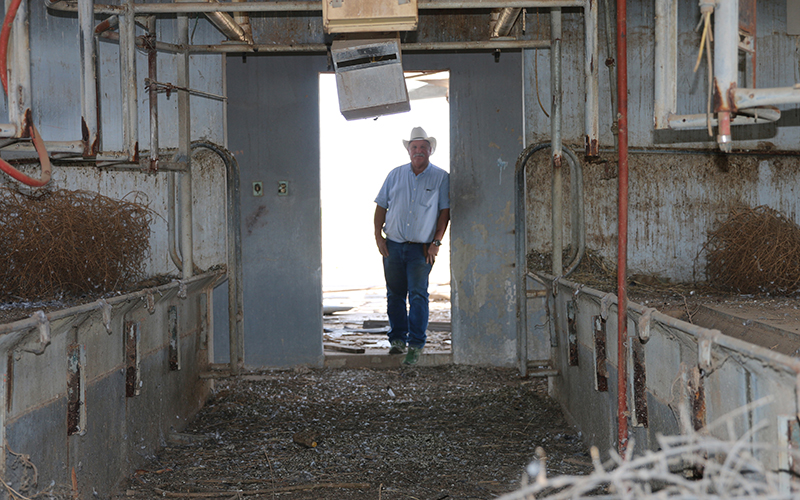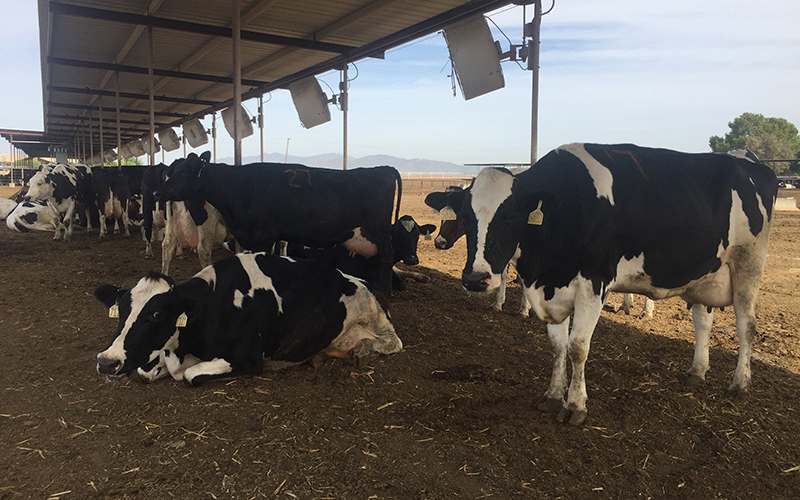- Slug: BC-CNS-Shrinking Farmland,1130
- Graphics on farms and farm acreage available (embed codes below)
- Photos, video story available (thumbnails, captions below)
EDS: A previous version of this story incorrectly reported the average size of farms in Arizona in 1997. The more than 8,500 farms in the state that year averaged just under 3,200 acres in size. The story below has been corrected, but clients who used previous versions of this story are asked to use the correction that can be found here.
By KRISTIANA FADDOUL
Cronkite News
BUCKEYE – Arizona farmland has declined over the decades, leaving one generation of a Buckeye farming family concerned and another content.
The Kerr family, longtime dairy farmers in Maricopa County, raised four generations of farmers in the Valley. Brothers David and Jerry Kerr, primary witnesses to the decrease in farmland over three decades, fear for Arizona’s agricultural future.
Their nephew, Wes Kerr, feels differently. He believes new efficiencies and technology mean farmers can do more with less land.
The generational differences demonstrate the changing nature of farms in Arizona, where the number of farms has grown over the last decade but available land and the size of farms is shrinking.
David Kerr said the economy changed in the early 2000s, bringing more retail and housing development to the region and pushing farms to the fringes of urban areas. He could have expanded to make more money, but couldn’t afford to do so. So he took another route.
“I sold my dairy in 2003, and have been in charge of Kerr Farm Tours for the last 12 years,” said Kerr, who works in the wheat industry. The program, which includes farm equipment and livestock such as cows, pigs, goats, is an exhibit at the Arizona State Fair.
A dilapidated, abandoned dairy farm now sits in a dirt field behind his home, reminding him of financial difficulties. The average market value of agriculture products sold at Arizona farms dropped nearly 60 percent over 15 years, according to the U.S. Department of Agriculture’s Census of Agriculture.
The number of farms in Arizona has increased – from more than 8,500 in 1997 to more than 20,000 in 2012, according to that census. But the average size of farms has steadily dropped, from just under 3,200 acres in 1997 to about 1,300 in 2012. Total acreage has dropped from more than 27 million acres in 1997 to about 26 million in 2012.
Kerr said there’s a byproduct of the loss in farmland: Children are less likely to be familiar with Arizona’s rich agricultural history.
“What we’ve noticed over the years with the farm tours is that the older generations come by and all of them will respond, ‘Oh, I remember that John Deere tractor because my grandfather had a farm,’” David Kerr said.
“We have generations of children now that don’t have that anymore, and it is very important for them to know where their food comes from and what these animals look like,” he said.
David Kerr’s exit out of farming came years after his oldest brother, Jerry Kerr, got out of dairy farming two decades ago.
“I had a dairy farm about a mile from here, and I had about 200 cows,” Jerry Kerr said. “Which really wasn’t enough, but it raised a family and provided a living for us.”
When it came time to expand or sell out, Jerry Kerr did what was best for his farm and his family.
“The economy of scale just wasn’t there for 200 cows, so I sold in 1996,” he said.
He has another agricultural job, as field supervisor for the Arizona Cotton Research and Protection Council. It gives him another perch from which to view Arizona farming.
“There is definitely a decrease in farmland,” Jerry Kerr said. “A lot of it is lost farmland to residential areas and water problems.”
“When I started with the organization I’m with now, there were almost 300,000 acres of cotton,” he said.
Cotton fields have seen an 85 percent decrease in acreage over two decades, Jerry Kerr said.
“The sector that I’m in charge of, which is basically from Casa Grande, central Arizona, and almost to the Colorado River, this year I had 43,000 (acres),” he said.
Jerry Kerr witnessed the decline firsthand throughout his 20 years in the cotton industry.
“There’s three cotton gins left in Arizona now, and there were, when things were booming, probably 30,” he said.
But Wes Kerr, a fourth-generation farmer and co-owner of Kerr Family Dairy, sees the upside to the situation that bedevils his uncles.
“Farmland is decreasing overall, and that is a really good thing,” he said.
In 2007, most Maricopa County farms were less than 10 acres, according to the Arizona Farm Bureau’s website.
“In Arizona today there are about 65 families that still dairy farm, where maybe about 30 years ago there were close to 400,” Wes Kerr said.
Current agricultural practices embrace sustainable farming, requiring less manpower, land and water.
“We are able to grow food with less land and less water,” Wes Kerr said. “The way we do that is by embracing technology.”
Arizona fields are laser leveled, he said. Tractors with laser-guided blades smooth out fields evenly, leading to proportional water distribution throughout the fields, reducing water waste.
Studying soil nutrients and breeding heartier crops also contribute to today’s efficient farming culture, Wes Kerr said. And nutritional diets, up-to-date animal health care and spacious living conditions led to increased milk production.
“Each cow produces about 75 pounds of milk per day,” he said.
That amount fluctuates throughout the seasons, with decreased production in the summer and increased production in the winter.
“Each cow is averaging 10 gallons of milk a day,” Wes Kerr said. “When you think about back in the day, when technology wasn’t up to date, there was no way a cow could produce 10 gallons of milk back in the ’40s.”
U.S. dairies produce more milk today with one-third the number of cows seen decades ago, he said.
“Back in 1940, in the United States, there were 26 million dairy cows,” Wes Kerr said. “Today there’s less than 9 million dairy cows, and with those 9 million dairy cows we’re producing more milk than they had with 26 million dairy cows.”
The rise of technology in farming has also led to job loss, forcing workers to migrate into related or separate industries.
“The most-developed cultures around the world have small agricultural sectors,” Wes Kerr said. “Those sectors are exceedingly productive, and only require a small percent of their population to grow food.”
Younger generations in farming families are choosing career paths related to farming. days, Wes Kerr said.
“I’ve had good friends of mine major in animal science,” he said. “Now they are nutritionists or veterinarians or other specialists to help with the farming community, but not actually own the farm or be a farmer, per se.”
Jerry and David Kerr may have different views from their nephew, Wes, on changes in the farming industry. But the family agrees that farming culture is in their DNA.
“The new generation of farmer we have now is more educated and more knowledgeable, but the person that still farms today is the same person that farmed 40 years ago,” David Kerr said. “That hasn’t changed, and I don’t think it will.”
^__=
_ Embed code for farms graphic: <script id=”infogram_0_fecc62a4-57cb-478d-af3a-918c4218f5be” title=”Number of Farms in AZ” src=”//e.infogr.am/js/embed.js?z4H” type=”text/javascript”></script>
_ Embed code for farm acreage graphic: <script id=”infogram_0_ed46ae53-d9cf-4aac-b967-e13686fc5da7″ title=”Acres per farm” src=”//e.infogr.am/js/embed.js?mvh” type=”text/javascript”></script>
^__=
Bill Kerr, who sold his dairy farm more than a decade ago, still has vestiges of the operation behind his Buckeye home. (Photo by Kristiana Faddoul/Cronkite News)
Kerr Family Dairy has more than 1,100 animals but is considered a small dairy farm by modern standards. The average Arizona dairy farm milks about 2,500 cows, Buckeye farmer Wes Kerr said. (Photo by Kristiana Faddoul/Cronkite News)

